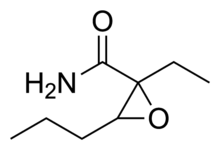This is an old revision of this page, as edited by CheMoBot (talk | contribs) at 21:12, 1 April 2011 (Updating {{drugbox}} (no changed fields - added verified revid - updated 'UNII_Ref', 'ChemSpiderID_Ref', 'StdInChI_Ref', 'StdInChIKey_Ref', 'ChEMBL_Ref', 'KEGG_Ref') per Chem/Drugbox validation (). The present address (URL) is a permanent link to this revision, which may differ significantly from the current revision.
Revision as of 21:12, 1 April 2011 by CheMoBot (talk | contribs) (Updating {{drugbox}} (no changed fields - added verified revid - updated 'UNII_Ref', 'ChemSpiderID_Ref', 'StdInChI_Ref', 'StdInChIKey_Ref', 'ChEMBL_Ref', 'KEGG_Ref') per Chem/Drugbox validation ()(diff) ← Previous revision | Latest revision (diff) | Newer revision → (diff) Pharmaceutical compound | |
| Clinical data | |
|---|---|
| ATC code |
|
| Identifiers | |
IUPAC name
| |
| CAS Number | |
| PubChem CID | |
| CompTox Dashboard (EPA) | |
| Chemical and physical data | |
| Formula | C8H15NO2 |
| Molar mass | 157.21 g/mol g·mol |
| (verify) | |
Oxanamide (Quiactin) is an anxiolytic and muscle relaxant which can produce sedative and hypnotic effects in sufficiently high doses. An uncontrolled trial on patients treated in a clinical gynecology practice published in 1959 found that oxanamide was efficacious in the treatment of anxiety resulting from premenstrual syndrome, menopause, and various other causes, with minimal sedation or other side effects.
References
- Kuhn, WL; Ketteler, HJ; Van Maanen, EF (1960). "Effects of oxanamide on the central nervous system". Proceedings of the Society for Experimental Biology and Medicine. 103: 101–3. PMID 14412594.
- Robert B. Woodhull (1959). "Oxanamide; adjunctive use of a new tranquilizer in gynecology". California Medicine. 90 (4): 275–7. PMC 1577644. PMID 13638840.
| Skeletal muscle relaxants (M03) | |||||||||||||||
|---|---|---|---|---|---|---|---|---|---|---|---|---|---|---|---|
| Peripherally acting (primarily antinicotinic, NMJ block) |
| ||||||||||||||
| Centrally acting |
| ||||||||||||||
| Directly acting | |||||||||||||||
This drug article relating to the musculoskeletal system is a stub. You can help Misplaced Pages by expanding it. |
This drug article relating to the nervous system is a stub. You can help Misplaced Pages by expanding it. |